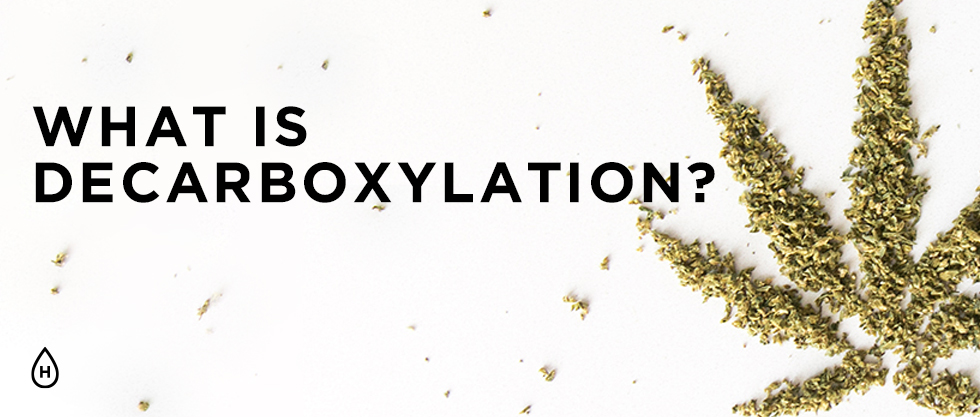If you’re wondering, “what is decarboxylation?” and you’re unsure how it relates to cannabis, you’ve come to the right guide. Even hemp flower, legally sold within the USA, needs decarboxylation to work as intended.
It’s become an all too common trope that raw cannabis is extremely potent. Simply eating the plant raw or stirred into something is enough to take someone out for an entire day. This misconception crawls its way into pop culture in movies, music, and even some games.
But the truth couldn’t be any more different.
The simple fact is, raw cannabis in its unaltered flower form is non-intoxicating. Eating marijuana or hemp raw won’t give you that cliche-stoned experience. It usually isn’t even easy—the plant itself is often extremely dry and not exactly tasty. The most you might experience is a strong desire to wash it down and know there’s wasted potential.
This is where decarboxylation comes in — the answer to making tasty edibles and potent products.
Every cannabis product, be it hemp or marijuana, must be activated. Otherwise, the cannabinoids inside the plant are left inactive. Inactive, they’re unable to deliver their beneficial effects.
Take even our own products for example. Our hemp flower is a potent way to get CBD, delta-8 THC, or a combination into your system. In its raw form, though, it can’t help with much of anything. Lighting it up through fire or a dry herb vape is what decarboxylates the compounds inside.
Meanwhile, our edibles are made from extracts that have already gone through decarboxylation. All you have to do is take a bite!
What is Decarboxylation?
Decarboxylation is a chemical reaction. It happens when removing a carboxyl group from a material, which releases that material’s carbon dioxide. This natural chemical reaction is extremely important for determining how cannabis will affect someone.
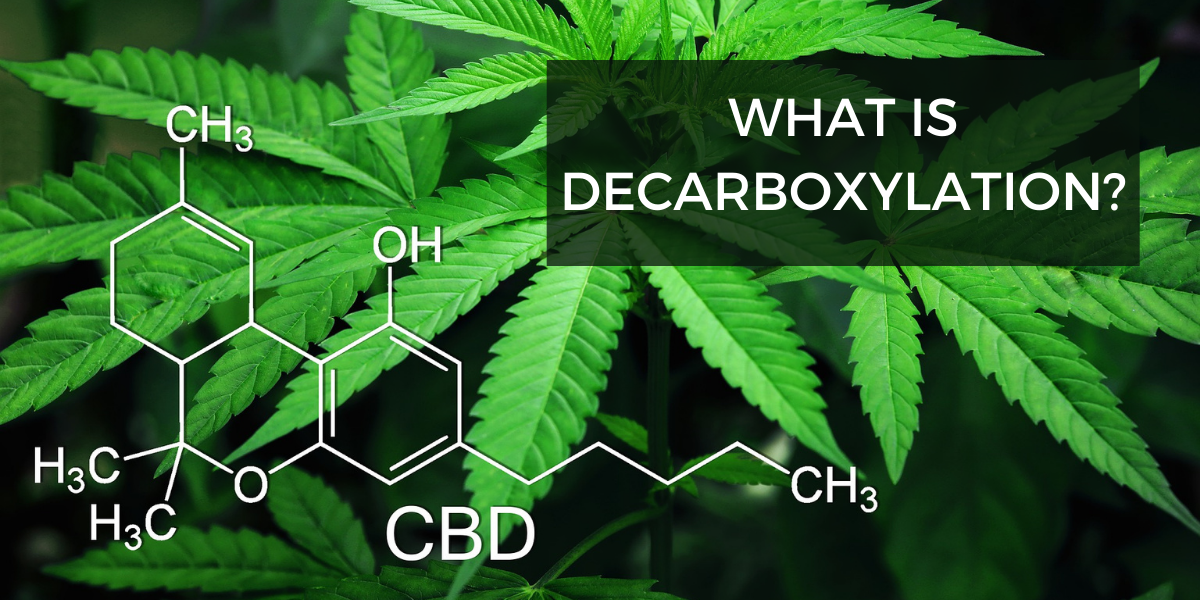
And while decarboxylation can happen naturally, there are also manual ways to induce this type of reaction.
Direct combustion, for example, is a process of instant decarboxylation. In simpler terms, we mean taking fire to your bud—usually with a lighter or match. The ignition and sustained burn of plant material is a much faster and effective means of the process. It also produces effects almost immediately.
Dry herb vaporizers can achieve the same level of decarb in the same amount of time. This process alters the chemical makeup of the starting plant and allows people to enjoy the product with all of its natural benefits.
Essentially, smoking hemp flower or puffing on a cartridge is decarboxylation in real-time. Just before the product enters your lungs, it’s altered through that chemical reaction. In an instant, the cannabinoids go from delta-8 THCa and CBDa to delta-8 THC and CBD. Now activated, you can expect significantly stronger effects and better use of your product thanks to decarbing.
Why Does Cannabis Need Decarbing?
It’s already widely understood that cannabis is enjoyed for its immediate and potent impact on the body. This is thanks to the decarbing process. Whether it be from directly smoking or baking the plant to use them in edibles, decarbing is a necessity.
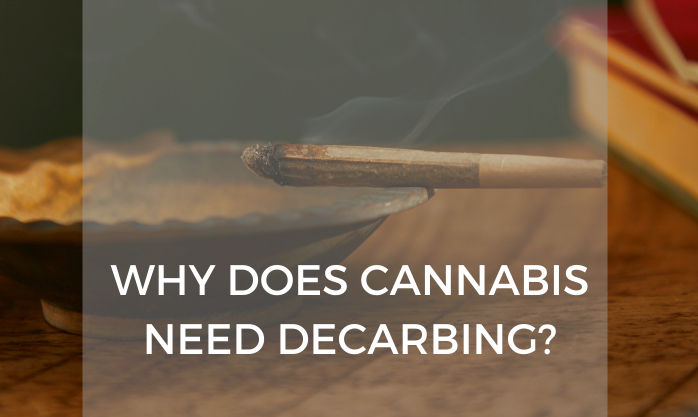
Lack of knowledge on decarboxylation is what leads to the most common mistakes among edibles and tincture DIY enthusiasts.
This doesn’t apply as much to baked goods as it does to other edibles. The temperature and time can help decarboxylate the cannabis in oven-baked treats. What it can affect negatively, however, is the production of goods such as cannabutter and canna-oil. These are not baked and therefore go unchanged.
The misunderstanding that cannabis is naturally psychoactive is based on what cannabis compounds are seen as. Most people think that cannabis is cultivated with high levels of active THC and CBD.
How Cannabinoids Transform
While there are some of these compounds already in the flower, most are composed of the base forms. Both THC and CBD have precursor forms that lack the active benefits that cannabis is known for. These are known as THC-A (tetrahydrocannabinolic acid) and CBD-A (cannabidiolic acid). Neither of these is psychoactive before decarboxylation, natural or otherwise.
During the heating process, be it direct ignition in fire or through decarbing in an oven, the molecular structure of the cannabinoid acids changes. Before decarboxylation, each cannabinoid acid has 22 carbon atoms, four oxygen atoms, and 30 hydrogen atoms.
One carbon atom and 2 oxygen atoms are removed from each structure and released as CO2. This restructures the THCa molecule and alters it to the active state, THC. Now that the process is complete, the newly formed THC is ready to be utilized by the brain through the endocannabinoid system.
Without this conversion to its smaller and more active state, THCa is not able to pass the blood-brain barrier and interact with our natural cannabinoid system. This transformation is also essential for the compounds to be introduced into different products for ingestion such as edibles or tinctures.
Does decarboxylation negatively impact CBD?
CBD-A found within raw cannabis also fails to impact the endocannabinoid system of its own accord.
While some may believe that only THC is a benefit from the process, CBD also needs the same steps to become effective. In fact, the same goes for any hemp compound, cannabinoid or otherwise.
Do concentrates need to go through decarb?
This is a bit of a tricky question, as most concentrates are created for direct use. The answer is empirically no—if you are dabbing, smoking, or vaping them. Due to the nature of how concentrates are made, the process and final product usually avoid exposure to heat. This means that the concentrate itself contains mostly THC-A and/or CBD-A.
Cannabis concentrate at this stage is ready for use even though it hasn’t been activated yet. This is because the process of smoking, vaping, or dabbing introduces high levels of heat that change the chemical makeup almost instantly. The resulting smoke or vapor is rich with activated THC, CBD, and other compounds at the moment of use.
How long should cannabis decarboxylate?
The amount of time it takes to decarb cannabis is based directly on the temperature. The lower the heat the longer the process. But on the other hand, too much heat can run the risk of combusting or scorching the plant material. This would destroy the compounds in them anyway, rendering the production useless. 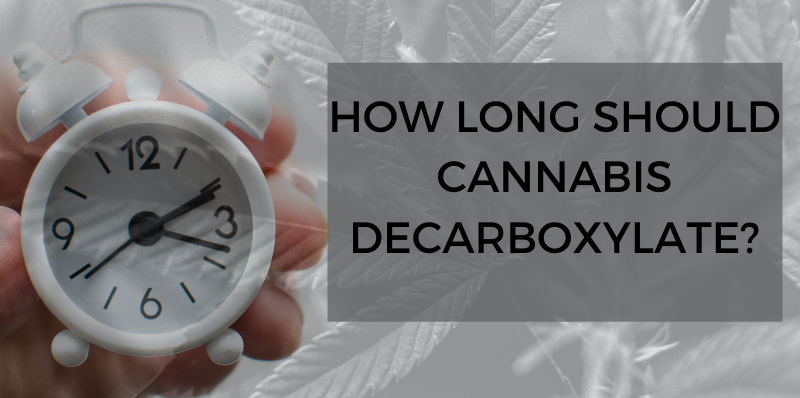
The ideal decarb process is to try to use the least amount of heat necessary. This is to help retain as many cannabinoid compounds and terpenes as possible. Terpenes themselves are especially vulnerable to accidental evaporation.
Not all acidic cannabinoids are converted during the process and trace amounts can still be found even after extensive decarb sessions. It’s also good to keep in mind that THC-A decarboxylates more quickly than CBD-A.
The longer the decarb session the more level the two compounds become. Studies have shown that decarbing for the full time to finish the CBD-A has no negative impact on the final quantity of THC.
The most common and accessible way to speed it up is to introduce the material to heat and time. Exposing cannabis to a temperature of 220 degrees Fahrenheit for between 30-45 minutes is the best way to initiate decarbing. Many people stick to the tried and true oven method to decarb their flower.
How do I decarboxylate flower at home?
While the science behind decarboxylation can be a little confusing, the process itself is still just two steps. Heat and time are the only factors you have to stay aware of if you want to decarb cannabis yourself.
Decarbing in an oven (with baking tray)
An average kitchen oven is more than capable of consistently decarbing cannabis. However, keep in mind that the temperature dial in an oven is more estimation rather than exact.
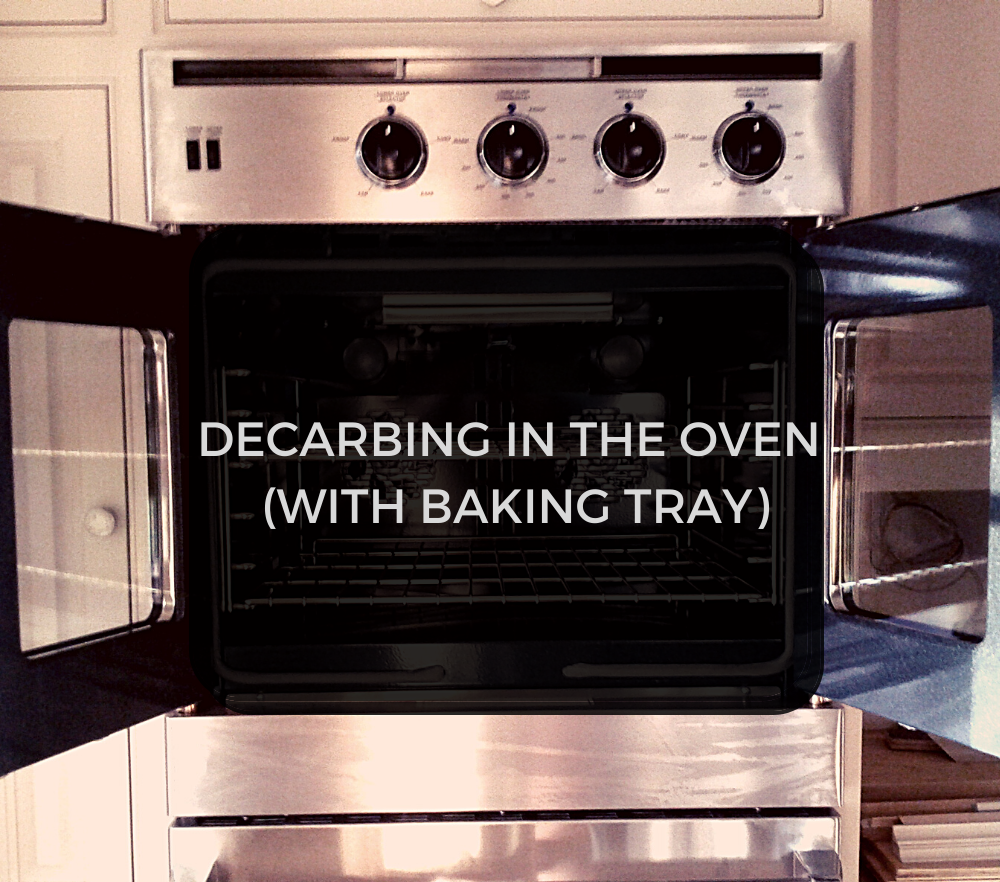 To get started you only need a short list of supplies:
To get started you only need a short list of supplies:
- A baking tray
- Parchment paper (preferred) or aluminum foil
- Cannabis flower (like our hemp flower options!)
Directions:
- Place the oven rack to the center spot. As ovens are warmer higher up and cooler towards the bottom, you want to get as close to an even temperature as possible. After placing the rack, preheat your oven to 225 degrees Fahrenheit.
- Lay your parchment paper onto your baking tray. If you are using aluminum foil try to make sure the sheet fits the full bottom of the tray and lightly crumple the edges. This layer will minimize direct contact with the tray. The tray itself conducts heat better than the protective layer, so you don’t want to risk contact with the cannabis. It could burn!
- Distribute the flower evenly across your lined tray after lightly breaking it up. Ideally, each piece should be around the size of a grain of rice. Anything smaller will increase the risk of burning. However, anything bigger may result in some of the flower not decarbing properly. After this, lightly lay another layer of lining across the top.
- Place the baking sheet with your flower in the oven for 45 minutes. For an average batch the size of a baking tray, this should be sufficient to effectively decarb the entire batch.
- After your 45 minutes are up, remove the tray from the oven and allow it to cool for 30 minutes at room temperature.
- When it is cool to the touch, carefully transfer your now decarboxylated cannabis into an airtight storage container to use as needed.
More About Using an Oven for Decarbing
Ovens usually have a fluctuation range of 20 degrees or more. If you rely only on the number you see, you could burn or under-process the plant. Keep an eye out for warning signs the temp is too high.
If you notice the flower browning quickly or smelling burnt, turn down the oven! You might also consider purchasing an oven thermometer to ensure everything stays consistent.
Decarbing in oven (with Mason jar)
There is a secondary method for achieving an oven decarb that has a small added change. This refines the process a little and reduces a few short fallings that the tray method contends with.
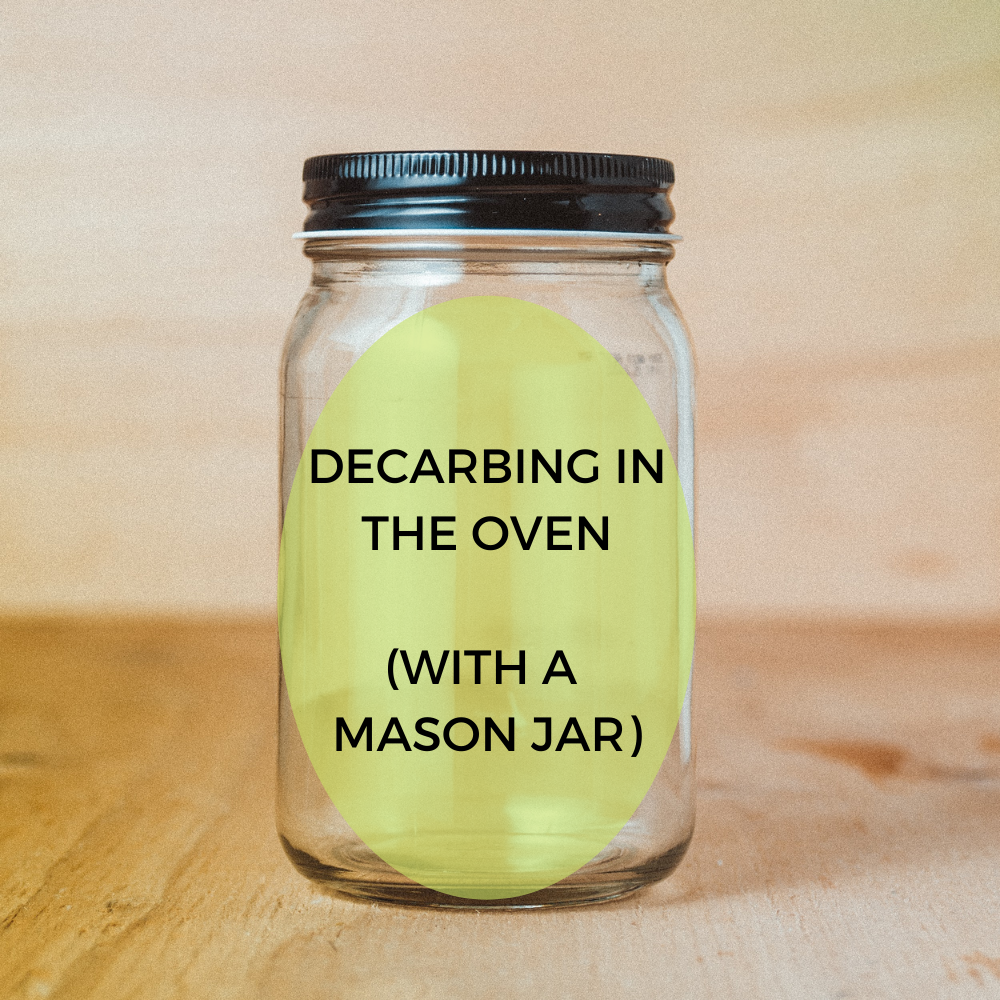 The first is odor. Using the mason jar method significantly reduces the strong smell that cannabis tends to produce while decarbing. Secondly, the mason jar method can act to preserve vital terpenes that tend to evaporate in the process. Instead of simply disappearing into the air, now they will stick to the sides of the jar. This can allow you to re-add them if you use the same jar for an infusion.
The first is odor. Using the mason jar method significantly reduces the strong smell that cannabis tends to produce while decarbing. Secondly, the mason jar method can act to preserve vital terpenes that tend to evaporate in the process. Instead of simply disappearing into the air, now they will stick to the sides of the jar. This can allow you to re-add them if you use the same jar for an infusion.
Most of the equipment needed for this method is the same as the standard oven tray one. The major difference is replacing the aluminum foil with a mason jar and towel.
So to list off the full list of supplies, you will need:
- A mason jar with a lid that fits
- Baking tray
- Kitchen towel
- Cannabis of choice
- Oven gloves
Directions:
- Place your oven rack into the middle position and set your temperature to between 220 and 240 degrees Fahrenheit.
- Break up your cannabis until it is about the consistency of rice grains.
- Place cannabis into your mason jar and lightly tighten your lid.
- Wet your kitchen towel lightly and lay it out on your baking tray before placing your mason jar onto it. This will help keep your jar standing upright and prevent it from sliding around.
- Place your tray with both towel and jar into the oven and bake it for 1 hour. Every 15 minutes you need to carefully remove the jar from the oven and shake it to keep the cannabis dispersed evenly.
- After 1 hour remove the jar from the oven.
- Allow your jar to cool for about 30 minutes before storing it for later use or using it immediately.
Decarbing with the sous vide method
The sous vide method is another tried and true process for achieving a consistent decarb of your cannabis. While this method and its simplicity are considered almost foolproof, you have to invest a bit more into your setup. 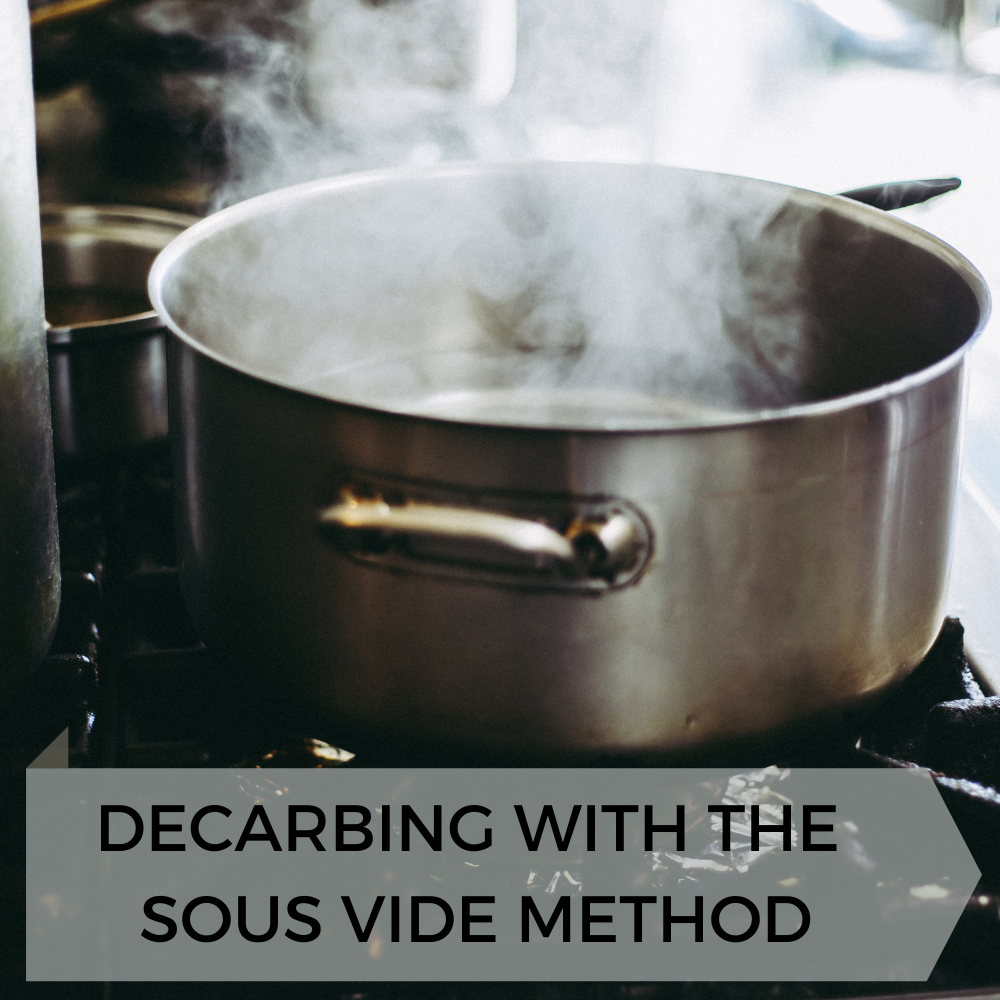
This is justified by how reliable it is for people who decarb cannabis regularly and use it often in cooking. A large portion of the initial setup cost is centered around the immersion circulator, which is used to regulate your temperature in this method. On average, immersion circulators can be purchased for around $100.
The benefits of an immersion circulator are based on its very precise temperature control. This allows you to maximize your terpenes and flavor profile and produce little to no smell.
For this method you will need the following:
- Immersion circulator
- A container for the immersion circulator (large cooking pots or plastic tubs will do fine)
- A vacuum sealer or alternatively zip-top freezer bag
- Cannabis of choice
Directions:
- Fill your large pot or plastic container with hot tap water before placing your immersion circulator inside. Follow your manufacturer’s manual to make sure the right amount of water is in the container. Finish preparations by setting the circulator to 203 degrees Fahrenheit.
- Grind your cannabis to a fine texture. Since your immersion circulator is so precise with temperature control, you run a very minute risk of overheating your plant. A fine grind is best with this method since you want to maximize your surface area.
- Using your vacuum sealer, remove all air from your bag of cannabis and seal it as flat and tight as possible. If you are using a freezer bag with a ziplock, use the water displacement method* to get as much air out as possible.
- Place your now sealed bag into the water for 90 minutes. This timetable is based on the relatively low but controlled heat offered by your immersion circulator and will give you the best carboxylation possible while preserving your terpenes and flavor.
- Remove your bag and let cool to room temperature. This should take between 15- 20 minutes. Once cooled, dry off your bag carefully and open it to transfer the now decarbed cannabis into your airtight container for future use.
* Water Displacement Method:
- Place ground cannabis in a zip-top freezer bag and close about 80% of the way.
- Slowly lower the bag into a container of water and allow the water to force out air as you go.
- Once the water is right below the zipper, close the bag completely.
Wrapping Up On: What is Decarboxylation?
In this guide, we went into depth on exactly what decarboxylation is. Then, we were able to describe multiple decarbing methods. With this knowledge, you have the power to decarb any hemp flower or cannabis at home. Whether you live in a legal state or enjoy our legal delta-8 products, there’s a lot to love about decarboxylation. Using one of the methods we mentioned above, you can ensure every bud is activated, potent, and powerful.
Which decarboxylation method sounds most promising to you? Have you ever tried any of these options out before? We’d love to hear about your past experiences. Furthermore, we hope this guide will help your future decarbing experiences be that much easier!
